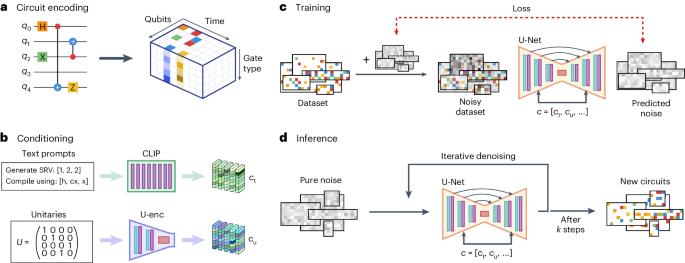Quantum circuit synthesis with diffusion models
IF 18.8
1区 计算机科学
Q1 COMPUTER SCIENCE, ARTIFICIAL INTELLIGENCE
引用次数: 0
Abstract
Quantum computing has recently emerged as a transformative technology. Yet, its promised advantages rely on efficiently translating quantum operations into viable physical realizations. Here we use generative machine learning models, specifically denoising diffusion models (DMs), to facilitate this transformation. Leveraging text conditioning, we steer the model to produce desired quantum operations within gate-based quantum circuits. Notably, DMs allow to sidestep during training the exponential overhead inherent in the classical simulation of quantum dynamics—a consistent bottleneck in preceding machine learning techniques. We demonstrate the model’s capabilities across two tasks: entanglement generation and unitary compilation. The model excels at generating new circuits and supports typical DM extensions such as masking and editing to, for instance, align the circuit generation to the constraints of the targeted quantum device. Given their flexibility and generalization abilities, we envision DMs as pivotal in quantum circuit synthesis, both enhancing practical applications and providing insights into theoretical quantum computation. Achieving the promised advantages of quantum computing relies on translating quantum operations into physical realizations. Fürrutter and colleagues use diffusion models to create quantum circuits that are based on user specifications and tailored to experimental constraints.


利用扩散模型进行量子电路合成
量子计算最近已成为一项变革性技术。然而,它所承诺的优势有赖于有效地将量子操作转化为可行的物理实现。在这里,我们使用生成式机器学习模型,特别是去噪扩散模型(DMs)来促进这种转变。利用文本调节,我们引导模型在基于门的量子电路中产生所需的量子操作。值得注意的是,DM 可以在训练过程中避开量子动力学经典模拟中固有的指数级开销--这是之前机器学习技术的一贯瓶颈。我们在纠缠生成和单元编译这两项任务中展示了该模型的能力。该模型擅长生成新电路,并支持典型的 DM 扩展,如屏蔽和编辑,以便根据目标量子设备的约束条件调整电路生成。鉴于 DM 的灵活性和泛化能力,我们认为 DM 在量子电路合成中具有举足轻重的作用,既能增强实际应用,又能为理论量子计算提供见解。
本文章由计算机程序翻译,如有差异,请以英文原文为准。
求助全文
约1分钟内获得全文
求助全文
来源期刊

Nature Machine Intelligence
Multiple-
CiteScore
36.90
自引率
2.10%
发文量
127
期刊介绍:
Nature Machine Intelligence is a distinguished publication that presents original research and reviews on various topics in machine learning, robotics, and AI. Our focus extends beyond these fields, exploring their profound impact on other scientific disciplines, as well as societal and industrial aspects. We recognize limitless possibilities wherein machine intelligence can augment human capabilities and knowledge in domains like scientific exploration, healthcare, medical diagnostics, and the creation of safe and sustainable cities, transportation, and agriculture. Simultaneously, we acknowledge the emergence of ethical, social, and legal concerns due to the rapid pace of advancements.
To foster interdisciplinary discussions on these far-reaching implications, Nature Machine Intelligence serves as a platform for dialogue facilitated through Comments, News Features, News & Views articles, and Correspondence. Our goal is to encourage a comprehensive examination of these subjects.
Similar to all Nature-branded journals, Nature Machine Intelligence operates under the guidance of a team of skilled editors. We adhere to a fair and rigorous peer-review process, ensuring high standards of copy-editing and production, swift publication, and editorial independence.
 求助内容:
求助内容: 应助结果提醒方式:
应助结果提醒方式:


